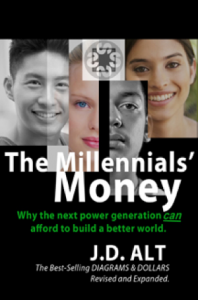By J.D. ALT
Classically, we imagine money being aggregated by an entrepreneur who uses it to build a factory, purchase raw materials, hire labor, and begin manufacturing widgets which are then sold in the marketplace. This same result could be had by the process of an ogre appropriating a factory by intimidation, acquiring raw materials by force, and using slave labor to produce the widgets. The difference is that, in the first case, the process produces customers (the laborers) who can purchase the widgets with their wages, whereas—in the second case—the ogre’s widgets have no paying customers. One model produces an economy, the other model doesn’t.
If we look at the modern global corporation, we see something of the ogre. Yes, they pay to build their factories—but prefer to coerce local communities into footing much of the cost through preferential land and tax deals (as well as, in many cases, the appropriation of local water supplies) in exchange for the “local jobs” the factory promises to create. They also do not outright “steal” their raw materials, but do manage to argue that the minerals existing in the ground of public lands are somehow theirs by right in exchange for a nominal rent. True, as well, they do not employ slave labor, but instead employ strategies that have, in the end, the same result: they minimize the use of local labor (all those jobs they promised to create) by using robotic technologies—and by outsourcing much of the “make-work” of the widget components to a country with cheap (some may even characterize it as “semi-slave”) labor. It is for this reason, of course, the same global corporation is so desperate for global trade agreements which will allow it to favorably access the markets to which it has outsourced its human labor—because that’s where the theoretical paying customers (the wage earners) are that its business model is creating.
In a similar vein, economists puzzle over the lack of inflationary pressure—indeed, the tendency towards deflation—in the modern western economies, even though the financial industries seem to be “creating money” at a historical pace. It might be that there’s something of the Ogre in that financial industry as well: the money it creates is not used to build factories, acquire raw materials, hire labor, and build widgets—it is used, instead, to make bets in the casino of the financial markets themselves. Poker chips are bought and played, but the chips never get redeemed, and they never leave the casino—except when they are used to buy political power and favor to perpetuate the game. (A few chips do get redeemed as spending money for the high-rolling players—and this does, in fact, put inflationary pressure on the prices for mega-yachts and London penthouses, but who really worries about that?) What matters is that the “money” generated by the casino never shows up is in the pockets of wage-earning customers on Main Street. Their pockets, if anything, contain fewer dollars than they did a generation ago—while the store fronts they gaze into contain more and more widgets assembled by robots with make-work parts fabricated by workers in other countries.
There is, in other words, a profound disconnect in the way things are functioning. The American economy has dropped a crucial cog out of its gear-box and, as a consequence, the gears on top are spinning wildly but futilely, while the disconnected gears on the bottom are grinding slowly and ineffectually. What we need to do, somehow, at all costs, is to put that missing cog back in the gear-box. Or—perhaps that is not exactly correct—we need to connect the drive-train directly to the lower gears themselves, and insert a cog let them drive the upper gears as, I believe, the machine was supposed to operate in the first place.


 I’m pleased to announce the book
I’m pleased to announce the book 








